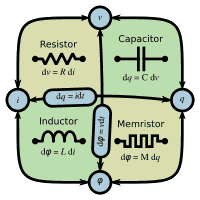Filipino’s Memristor is Now a Reality
May 03 2008 Sat
2:32 am PHT
The big news that’s rocking the physics, electrical and electronics engineering fields is the proof of the existence of the memristor. “Mem-what?” Well, that’s what my initial reaction was, too. The memristor is apparently the missing fourth fundamental basic element of electrical circuits, alongside the resistor, the capacitor, and the inductor. And the cool thing about this is that the memristor was first hypothesized in 1971 by Leon Chua, a Filipino-American professor at the University of California at Berkeley who got his degree in B.S. Electrical Engineering at the Mapúa Institute of Technology in 1959, here in the Philippines! Yay, Pinoy!
Basically, the memristor, short for “memory resistor,” is a passive electrical device whose electrical resistance is a function of how much current had passed through it (well, more or less). To imagine how this works, think of an incandescent light bulb connected to a DC battery. A light bulb is actually just a simple resistor (that simply happens to give off light). This light bulb shines at a steady brightness because it has a constant resistance and is fed by a constant voltage and passes through a constant current. Now imagine that the light bulb has characteristics of a memristor instead of a resistor. What happens is that the light bulb will grow progressively brighter the longer it is connected to the battery—it’s resistance decreases. Now, reverse the connection of the memristor light bulb to the battery (swapping the electrodes) and you should see it grow progressively dimmer—it’s resistance increases.
The memristor was developed by engineers at HP Labs last month and was announced on April 30 (see the articles in Nature and the EE Times.) What the HP engineers did was to dope a thin film of titanium-dioxide with depleted oxygen atoms and the oxygen “holes” move—increasing or decreasing the film’s resistance—when an electrical current is applied to the film in one or the other direction.
One good application of memristors is as a form of memory storage. While DRAMs (e.g., your typical SDRAM) store binary 1’s and 0’s via charged or uncharged capacitors, memory-based memristors store 1’s and 0’s via high and low resistances. And unlike DRAMs that lose their data when power is turned off, memristors don’t. As a proof of concept, the guys at HP Labs have managed to use memristors to store 100 gigabits on a single die in one square centimeter. While this is comparable to today’s existing hard disks and flash drives, the prototype memristor storage has access times similar to DRAMs—much, much faster! And these are just prototypes. HP thinks that they can push the storage up to 1 terabit or more. (See this ars technica article to learn more.)
One particularly interesting property of the titanium-dioxide memristor is that its effect becomes more pronounced the smaller it becomes. Plus, it doesn’t generate the excess heat that’s now cooking your thighs underneath your laptop. Memristors have far-reaching implications for the computer industry because memristor-based transistors can be constructed much, much smaller than today’s semiconductor-based transistors, thus potentially pushing Moore’s Law a lot further into the future, something that had been troubling the semiconductor industry for sometime now.
It’s a good thing that I’m already done with my B.S. Computer Engineering degree. The reality of the memristor means that electrical and electronics textbooks definitely need to be rewritten. I have a good cognitive grasp of how resistors and capacitors work, but somehow, inductors fumble me. What more with memristors! Hehehe.
A big thanks to Urbano for blogging about the memristor. The image above is from the Wikimedia Commons.


Comments
Comments are currently disabled.